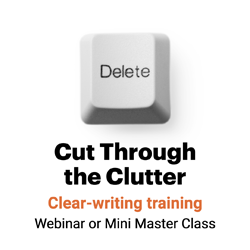Hit return more often
The problem with long paragraphs is that they look hard to read. And because they look hard to read, people don’t read them.

That’s right: Readers skip long paragraphs. So if your paragraph is too long, you might as well stamp on it in red ink, “Don’t bother reading this paragraph. Our lawyers made us add this stuff. We formatted it this way on so you’d skip it.”
“Long paragraphs are a visual predictor that a story won’t work.”
— Jon Ziomek, associate professor at the Medill School of Journalism
If you’re cranking out paragraphs of 200 words, nobody’s going to read them. So how long is too long for a paragraph?
Write like the Times.
We turned to The New York Times to find out. We analyzed all of the stories in a single edition of the Times. (We skipped the sports pages.) On this day, paper’s paragraphs:
- Ranged from 9.6 to 67.5 words long.
- Averaged 36 words per paragraph.
- Weighed in at a median of 37 words per paragraph.
Hey, if it works for the Times, it works for me. Let’s aim for a rule of thumb of 36 to 37 words per paragraph. An occasional 9- or 68-word paragraph? That works for me, too.
And what about the number of sentences per paragraph? The Times’ paragraphs:
- Ranged from 1.3 to 9 sentences per paragraph.
- Averaged 2.4 sentences per paragraph.
- Weighed in at a median of two sentences per paragraph.
Are you having flashbacks to your third-grade English class? Are you remembering your teacher telling you that a paragraph includes five sentences: a topic sentence, three developing sentences and a concluding sentence?
That’s academic writing. This is marketing writing. Your audience members are never going to read those 200-word paragraphs. (Remember: Your teachers got paid to reach what you wrote.)
So how do you turn longer paragraphs into shorter paragraphs?
To craft short paragraphs:
1. Hit return more often.
This may be the easiest single thing you can do to cut through the clutter in your copy.
I know, I know. Your third-grade teacher taught you that paragraphs were one unit of thought. They are. Just as your entire piece covers one idea, your sentences are units of thought, your words each express a single idea — heck, even the syllables each convey a concept.
You just need to see your thoughts as smaller, more discrete units.
David A. Fryxell, former editor of Writer’s Digest, recommends that you hit return when you need to:
- Pause
- Elaborate
- Change topic
- Make an aside
- Present a quote
- Shift time or place
- Emphasize a key point
- Explain a subsidiary idea
- Offer an opposing viewpoint
- Change the rhythm of your piece
- Move to the next item on your list
Great guidelines. But the only real rule is that you place your curser after a period before you hit return.
2. Tweak it.
Look for ways to shorten your paragraph by cutting sentences, phrases and words.
3. Break it with bullets.
If you have a series of three or more items, break them out of the paragraph in a bulleted or numbered list. Bullets not only break up a paragraph, but they also cut words by eliminating the need for transitions.
What about the lead paragraph?
With the lead paragraph, you have a choice. You can build a bridge that your readers can easily walk over to get into your story. Or you can erect an obstacle that readers have to climb over to get into your story.
What’s a good length for a bridge?
Twenty-five words, according to the Circulation Managers Association Education Committee.
But a great lead can be even shorter. You can often open a release, posting, brochure or article in a single sentence — even a single phrase. (Remember, you don’t have to tell the whole story in the lead. That’s what the rest of the article is for!)
When The Wall Street Journal covered the fact that Douglas Investor, chairman of Coca-Cola, was leaving his post after only two years on the job, the first paragraph read in its entirety:
So fast?
Return.
It’s not the job of the first paragraph to tell the whole story. That’s the job of the whole story. The job of the first paragraph is to get the story started — and get people to read the second paragraph.

Leave a Reply